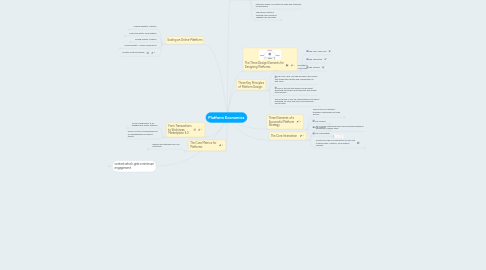
1. content which gets a minimum engagement
1.1. Measuring number of Creation and Consumption is often not enough. The percentage of content which gets a minimum engagement is an important indicator of quality
2. The Core Metrics for Platforms
2.1. measure and optimize the Core Interaction.
2.1.1. The goal of a platform is to repeat and optimize the Core Interaction that creates value
3. From Transactions to Stickiness: Marketplace 3.0
3.1. Six key mechanisms to an engaged and ‘sticky’ platform
3.1.1. Reputation Systems: Marketplaces like Airbnb and TaskRabbit create stickiness by helping a user build reputation across transactions.
3.1.2. Collection: User collections and collection management tools can make buyers sticky. A wishlist or wardrobe feature allows buyers to collect listings and items of interest.
3.1.3. Personalized Feed: Marketplaces can also improve buyer retention by personalizing. Most buyers will only spend a limited time on the marketplace. The limited time spent on the marketplace caps the amount of transactions a user may engage in.
3.1.4. Influence: Seller-centered marketplaces are different from listing-centered marketplaces. Seller-centered marketplaces allow sellers to brand themselves, build a following and create influence. Sellers regularly push out content on their wares.
3.1.5. Workflow management: In order to create stickiness for both parties on a services marketplace, these platforms are moving from a transaction-only model to a workflow management model. Traditional service based marketplaces often fail to own the transaction.
3.1.6. Substituting transactions with subscription Marketplaces that can offer a fairly guaranteed form of service, often move from an a-la-carte transaction model to an all-you-can-eat subscription model.
3.2. Focus not just on transactions but on strengthening of network effects
4. Scaling an Online-Plattform
4.1. Scaling Quantity: Creation
4.1.1. Understand the motivations of the creators
4.1.2. Create enabling technology that caters to those motivations
4.1.3. Lower (or completely remove) the barrier to getting something done
4.1.4. Clear strategy to maximize the number of creators
4.1.5. Scaling consumption is a critical step to scaling interactions
4.2. Scaling Quantity: Consumption
4.2.1. capture data about the consumer
4.2.2. start acquiring data about users the moment they sign up
4.2.3. use data to make relevant recommendations
4.2.4. Encourage users to follow topics or listings
4.2.5. create opportunities for transactions in the future without the user explicitly initiating one
4.3. Scaling Quality: Curation
4.3.1. Scaling editorial / social curation
4.3.1.1. Editorial actions scale only when they are gradually moved out to the community over time
4.3.1.2. Educating the community on how to curate and ensuring that the tools of curation (e.g. rating, review, reporting etc.) are being used correctly and often enough
4.3.1.3. Reputaion: Differentiate highly reputed users from less reputed ones
4.3.2. Scaling algorithmic curation
4.3.2.1. improving the algorithms themselves
4.3.2.2. improving the inputs to the algorithms
4.4. Scaling Quality – Overall Governance
4.4.1. creating centralized trust mechanisms becomes critical to ensuring widespread adoption among mainstream users
4.5. Growth Hacking Strategy
5. Three Key Principles of Platform Design:
5.1. Start with defining the value that is created or consumed, the Core Value Unit.
5.2. The Core Value Unit should lead to the actions that enable the creation and consumption of that value.
5.3. Only in the last step should one go about designing the system and interfaces that enable those actions.
5.4. Rule of thumb: If you are a new platform and you’re designing for more than one core interaction, you’re toast!
6. Frank Schultheiss - based on Platform Thinking Labs Articles by Sangeet Paul Choudary www.schultheiss.tv
7. The Core Interaction
7.1. set of actions that producers and consumers engage in repeatedly to derive value.
7.2. All actions in the core interaction fall into one of the buckets: Creation, Consumption, Curation
7.2.1. Creation: producer who creates value
7.2.2. Consumption: consumer, who consumes value
7.2.3. Curation: To encourage good quality and quantity of value creation, as well as to ensure the right consumers consume it, you need some form of curation.
7.2.4. You need all three actions: Creation, Curation and Consumption to repeatedly occur for the platform to work properly.
8. The Three Design Elements for Designing Platforms
8.1. The Core Value Unit
8.2. The Interaction
8.3. The Platform
9. Three Elements of a Successful Platform Strategy
9.1. The success of a platform strategy is determined by three factors:
9.1.1. Connection: how easily others can plug into the platform to share and transact
9.1.2. Gravity: how well the platform attracts participants, both producers and consumers
9.1.3. Flow: how well the platform fosters the exchange and co-creation of value
9.2. The Toolbox
9.2.1. The Toolbox creates connection by making it easy for others to plug into the platform. This infrastructure enables interactions between participants. For example, Apple provides developers with the OS and underlying code libraries
9.3. The Magnet
9.3.1. The Magnet creates pull that attracts participants to the platform with a kind of social gravity. For transaction platforms, both producers and consumers must be present to achieve critical mass.
9.4. The Matchmaker
9.4.1. The Matchmaker fosters the flow of value by making connections between producers and consumers. Data is at the heart of successful matchmaking, and distinguishes platforms from other business models.
10. What is it?
10.1. An approach to enable external value creation to scale existing or build new business
10.2. Platforms power co-creation by users and extension by developers.
10.3. The phrase "Platform Thinking" was coined by Sangeet Paul Choudary
10.3.1. “A platform is a plug-and-play business model that allows multiple participants (producers and consumers) to connect to it, interact with each other and create value.”
